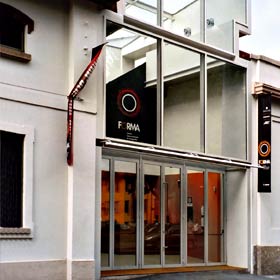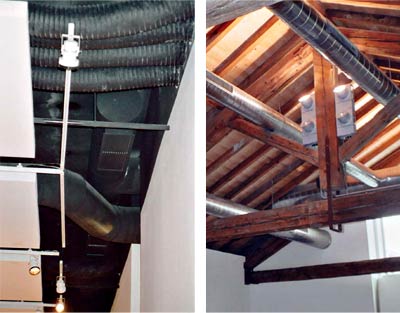A facility dedicated to photography
 his multi-purpose exhibition centre, dedicated to photography, has been built in the style of an old Milanese tram, It offers vast areas of space and utilises advanced VRF air conditioning systems, developed by Mitsubishi Electric, incorporated within the structure of the building to harmoniously provide accurate climate-control throughout both summer and winter.
his multi-purpose exhibition centre, dedicated to photography, has been built in the style of an old Milanese tram, It offers vast areas of space and utilises advanced VRF air conditioning systems, developed by Mitsubishi Electric, incorporated within the structure of the building to harmoniously provide accurate climate-control throughout both summer and winter.
A small entrance hall, comprising a full-length glass wall extending above the lowest of the adjacent buildings and adorning a beautiful skylight, is what is most striking about the new Spazio Forma, in Piazza Tito Lucrezio Caro, 1 in Milan. On entering the lobby, the space expands and expands where, to start with, visitors feel quite surprised, a feeling that then changes to appreciation as they experience the sense of tranquillity the exhibition area is able to generate.
This new and unusual multi-purpose exhibition centre designed by Franco De Nigris, exploited the space originally used by an old Milanese tram station, where even now, in this virtual museum, visitors can appreciate the design of the old trams dating back to the beginning of the 1900’s, through a full length glass wall in one of the rooms. The vaguely trapezoidal plan of the ground floor area continues throughout the exhibition rooms, bookshop and rest rooms, and create exhibition routes and special oasis-like areas of particular significance for visual arts.
However, moving up from the ground floor to the first floor, a totally different feeling rewards the visitors in the main hall, created by the sloping roof and the exposed wood beams which support it. Unlike conventional attics, however, which are usually penalised by a lack of light, one end of the hall opens onto a terrace which receives sunlight and takes advantage of an additional expansion of space. Access to the terrace, along the balcony overlooking the atrium also benefits from sunlight received through the overhead skylight. And, in fact, despite being a relatively short distance, this is what gives the whole area a sense of space and freedom.
Spazio Forma was inaugurated with the photographic exhibition by Gianni Berengo Gardin – with the unique black and white works on human and social issues – and from the very moment of its initial opening to a curious and attentive but by no means unprepared or less critical public, it immediately showed its capacity to meet the communication and exhibition demands asked of it.
Superior comfort for visitors thanks to VRF air conditioning
Superior comfort for visitors thanks to the VRF air conditioning, where what is perhaps less noticed, because completely invisible, was the capacity of the air conditioning system, manufactured by Mitsubishi Electric, to maintain the indoor comfort level under control, allowing visitors, throughout the entire premiere evening, to enjoy the evening, chatting and admiring the works on display without any discomfort. And this was possible, despite the attendance of a far higher number of visitors that normal.
This success can be attributed to air conditioning systems with variable refrigerant flow (VRF) produced by Mitsubishi Electric and integrated with the ventilation and air handling that have allowed both to maintain the room temperature to the value of wellness and control the relative humidity to prevent sweat and discomfort to people and, not least, provide ventilation with outdoor air. All this was confirmed with no stretch marks during his inauguration, in a typical summer day in Milan, hot and humid, which has seen the influx of several hundred visitors.
An invisible ultra-silent installation
The air conditioning system is invisible because the architect, Franco De Nigris, found an unusual and highly functional solution for the exhibition halls on the ground floor, capable of hiding the already compact indoor units and air distribution ducts completely. This was seconded quite masterfully by Progetto Clima Spa and Eng. Sergio Dodich, who actually produced the egg and listening equipment. The large white horizontal panels, used to partially lower the ceilings in the halls, hide all the air conditioning ducts which diffuse the air silently throughout the environment through the breaks that separate the panels themselves. This solution allowed them to eliminate all "objects" or equipment units that might otherwise distract attention from the works of art on display and alter the essential design of the rooms. The result instead actually managed to favour a more intimate relationship between the person and the image.
The horizontal air conditioning units are suspended above the panels from which the round air distribution ducts depart, painted black like the colour used for the ceiling structure; they pass unnoticed even in the short stretches in which they could be seen, between one another and another or between a panel on the wall.
These air ducts are fitted on two sides with special nozzles, which circulate the air in the exhibition area areas through the panels themselves. This was only made possible using the use of Mitsubishi Electric VRF systems which allow installers to hide them, and minimal space requirements thanks to the compact size of each individual component.
The solution chosen for the large upper hall is however radically different, where the air conditioning is distributed by circular ducts of galvanized sheet metal that are laid parallel to the large beams that support the structure of the sloping roof. Left in view, the circular ducts are included almost like complementary elements, and somehow blended within the overall image seen by the visitors.
The outdoor units which, in all other types of installations, almost always involve serious problems concerning installation and noise, were installed in a separate area almost entirely hidden from view, and their sound level falls well below the welfare thresholds foreseen for this type of application and urban area. Once again, the VRF air conditioning systems have demonstrated their superior level of flexibility and ability to be installed in tight spaces, something that is impractical for similar conventional systems.
Air quality and energy recovery
The air conditioning units provide continuous recirculation, filtration, cooling and dehumidification of ambient air. To check the quality of the air itself, and allow satisfactory ventilation with fresh air taken from outside, Mitsubishi Electric Lossnay cross-flow type heat recovery units which recover the cooling power contained in the exhausted air, in order to pre-cool the warm humid air into the room from outside. This generates significant energy savings and operating costs, as the efficiency of these recovery installations reaches an outstanding 80%.
The removal of exhausted air is carried out in certain parts of the premises by means of appropriate grilles applied to the bottom section of the wall, without any other forms of alteration necessary.
In total, six VRF systems were installed, which perform both the air conditioning in summer, and heating in winter using a Spazio Forma heat pump. The installed cooling capacity is 189 kWf whilst the heating capacity is equal to 213 kWt. Mitsubishi Electric VRF technology has not only generated impeccable conditioning by Spazio Forma, but also achieved this result with a minimum use of electricity, thanks to the extremely high energy efficiency of the equipment which reduces the environmental impact of the building and also generates a significant decrease in operating costs.
Management strong points
A further highly innovative element that qualified this project, and made it possible to fully achieve all the results concerning comfort and performance, was the sophisticated management system provided by the Mitsubishi Electric VRF systems. In fact, the systems are managed through a centralised control unit that detects all environment parameters, using a microprocessor with LCD display and standard Ethernet network interface, without any additional software needed. It can be connected directly to existing or dedicated LAN/WAN networks and has an integrated web server which uses the Internet Explorer browser. The management system allows control over all aspects of comfort: on/off, cooling, heating, dehumidification, automatic ventilation, temperature control, variable fan speed etc.. In addition, it also manages and reports alarms triggered by possible failures or malfunctions to allow for targeted and timely interventions.
A successful system
Today's architects are constantly faced with the challenge of combining technical installations within recovered and restructured buildings, and have to deal with a variety of countless constraints and requirements: mechanical, electrical, dimensional, acoustic. Of the over 10,000 VRF installations in Italy using systems manufactured by Mitsubishi Electric, at least 30% were designated to restructured buildings, and every time they achieved levels of complete satisfaction for the Project Architect, the Customer and the end user.
In actual fact, the advantages of the VRF systems can be summarised in some key aspects which reflect their positive compliance with all restructuring requirements :
- Minimum space needed for the installation of the units, much lower than those using hydronic systems;
- Lightweight units which can be installed anywhere thanks to their modular design;
- Small diameters of the cooling lines connecting the outdoor and indoor units, significantly lower compared to water supply systems, with greater ease of passage through walls etc.
- Cutting edge hi-tech management system providing remote control options via the Internet without additional software needed;
- primary air handling systems with high efficiency heat recovery systems to ensure control over relative humidity within the premises and ventilation as required by the applicable laws and standards;
- High energy efficiency, and hence in outstandingly low environmental impact;
- of the cooling and heating capacity of the installations using an Inverter that controls compressor speeds, obtaining a precise response to user requirements;
- Ultra silent operational qualities which means Mitsubishi Electric VRF systems can also be used in protected areas.

The ducts and relative conditioned air distribution grilles are installed above the suspended ceiling tiles and painted black, like the structural ceiling, in order to be invisible from the exhibition space.
The large hall on the first floor is characterised by the sloping wooden roof with exposed beams. The air conditioning ducts are made from circular galvanized steel, and run along the entire length of the roof blending with the general overall structure.
If one considers the results achieved in 14 years of business in Italy, we can say that the ME VRF systems, installed within a wide range of applications, provide the ultimate answer to all third party building climatisation requirements plus a number of other special applications
Spazio Forma in numbers:
- Covered surface: 1,200 m2
- Total surface: 1,500 m2
- Number of outdoor VRF units installed: 6 , mod. PUHY-P315YEM-A
- Number of indoor VRF units installed: 20, mod. PEFY-P 80VMM-E
- Number of heat recovery units installed: 14, mod. GUF-100RDH3
- Total installed cooling capacity: 189 kWf
- Total installed heat pump warming capacity: 213 kWt
- Total handled air capacity: 13,500 m3/h.
WORK PROJECT PARTICIPANTS
The project was managed by Eng. Sergio Dodich, Progetto Clima Sifitto.
Download
Ιστορικό της υπόθεσης
Download the complete Case History
Download

